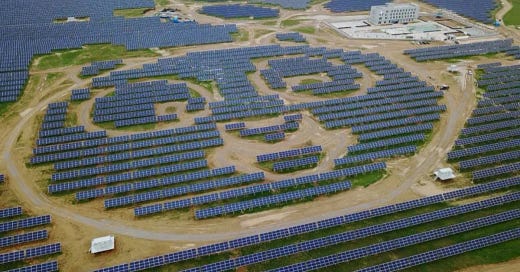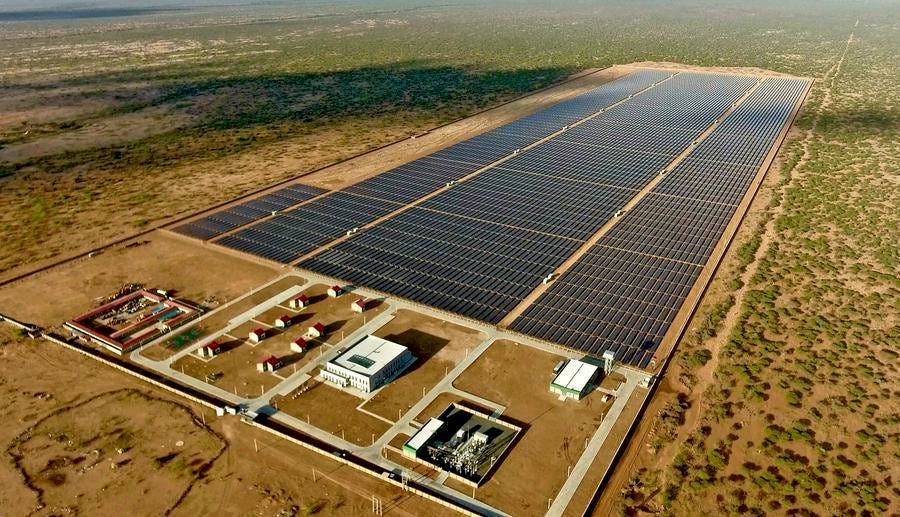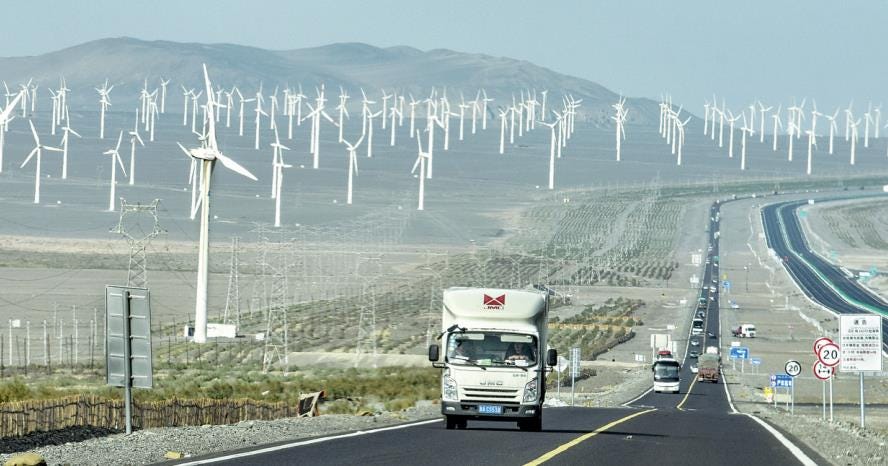As we enter the second half of 2026, some of China’s renewable energy generation marks are being published that makes the Outlaw US Empire a laughingstock. China’s doing this work for two reasons: Environmental logic and preparing for the massive energy requirements the future will demand led by AI and other high technology accomplishments. In the translated Guancha article that follows, there’s no mention of potential fusion energy generation because it has yet to become a proven provider of energy. China’s methodical green energy drive is powered by an unwavering government policy that’s committed to doing the right thing while also shaming its geoeconomic rival, the Outlaw US Empire which has effectively surrendered.
"We knew China was pushing wind and solar power on a large scale, but we were blown away"
The rapid growth of China's installed capacity of new energy is an important manifestation of China's active commitment to addressing climate change and promoting green and low-carbon development.
The Guardian reported on June 26 that China now has more than 1,000 gigawatts (GW) of installed solar capacity, accounting for half of the world's total. In particular, since the beginning of this year, China's renewable energy expansion has continued unabated, with 198 GW of new solar and 46 GW of wind power capacity added in the first five months alone, enough to generate electricity equivalent to the whole of Indonesia or Turkey, of which the new capacity in May is equivalent to the power generation of the whole of Poland.
Lauri Mirvirta, a senior fellow at the Asia Society Policy Institute, lamented: "We knew for a long time that China was accelerating the installation of wind and solar, but we were blown away by the speed. ”
As China, the world's second-largest economy*, accelerates the construction of renewable energy infrastructure, the installed capacity has once again broken a number of records, the report said. According to Mirvirta's analysis, China's new solar capacity reached 93 gigawatts in May, which is equivalent to installing nearly 100 solar panels per second. The installed capacity of wind power is 26 gigawatts, which is equivalent to about 5,300 wind turbines. [*This is incorrect; China’s economy is larger than the Outlaw US Empire’s when proper adjustments are made.]
While the amount of electricity generated by solar panels and wind turbines will vary depending on location and weather conditions, Mirvirta estimates that China's new capacity in May alone would be enough to provide as much electricity as Poland, Sweden or the United Arab Emirates.
"We've known for a long time that China is accelerating the installation of wind and solar, but the pace is still staggering." Mirvirta wrote on social media.
According to a spokesman for the National Development and Reform Commission on June 26, as of the end of May this year, the country's cumulative installed power generation capacity was 3.61 billion kilowatts (1 gigawatt = 1 million kilowatts), a year-on-year increase of 18.8%, and the power supply and demand situation was better than last year. It is preliminarily estimated that the highest electricity load in the country will increase by about 100 million kilowatts year-on-year during the peak summer this year. In response to this situation, the National Development and Reform Commission, together with relevant parties, has focused on improving the power supply capacity, and has taken a series of measures to strengthen the construction of energy production, supply, storage and marketing system in advance.
According to the latest data released by the National Energy Administration, in the first five months of this year, China's new photovoltaic installed capacity was 196 million kilowatts, a year-on-year increase of 57%. At present, the installed capacity of photovoltaic power generation has historically exceeded 1 billion kilowatts, reaching 1.08 billion kilowatts, equivalent to the total installed capacity of about 48 Three Gorges power stations.
The installed photovoltaic capacity of more than 1 billion kilowatts can generate 1.2 trillion kilowatt-hours of green and clean electricity a year, accounting for 12% of China's total annual power generation, replacing 152 million tons of standard coal, and meeting the annual electricity demand of nearly 500 million households.
According to the "Global Offshore Wind Power Market Outlook" and the "Global Wind Energy Report" released by the 2025 Offshore Wind Power Conference on June 20, China's wind power installation capacity has grown rapidly since the beginning of this year, and wind power generation accounts for more than 12%. By 2030, the global installed capacity of offshore wind power is expected to exceed 230 GW, of which China's deep-sea projects will become the core growth point of international cooperation.
According to the data, as of April, China's cumulative grid-connected installed capacity of wind power has accounted for 15.5%. In the first four months of this year, China's wind power generation reached 381.43 billion kilowatt hours, accounting for 12.78% of the total power generation.
With the rapid growth of wind power installations, the cost of wind power will also be lower and lower.
The Guardian notes that climate talks between China and the United States have been fraught with twists and turns since Trump entered the White House in January 2025. Trump has withdrawn from a number of important environmental agreements, including the Paris climate agreement. Trump also declared at the time that "the United States will not destroy its own industry while China is reckless in its emissions."
Now, in the face of China's stellar clean energy figures, Trump's accusations are ironic. After all, while China is fulfilling its climate change commitments step by step, the Trump administration is reversing a series of clean energy policies, and American politicians are still fighting over their own political selfish desires, even using the "China card" to play right and wrong.
On April 27, former U.S. Treasury Secretary Henry Paulson wrote an article in the Financial Times, reminding the Trump administration that it must implement a sober and pragmatic national energy strategy, and that clean energy is essential if the U.S. is trying to win the AI race with China.
He said the Chinese government's goal is to dominate the technology of the future, and they know that energy policy will be key. In 2024, China will invest more in renewable energy than the US, EU and UK combined. In the United States, electricity demand has grown faster than utilities to build capacity.
Simon Evans, an analyst at Carbon Brief, a British research firm, said in March that China's clean energy investment is expected to grow further in 2025. China has obvious advantages in the clean energy industry, is competitive globally, and will continue to thrive. At the same time, under the goal of energy transition, the development of clean energy technology industry is an inevitable choice for China. In addition, China is a solid force in the fight against climate change. In the future, clean energy technology will continue to support China's economic development. [My Emphasis]
China’s also very keen on exporting its solar tech and constructing solar farms. The one below is in Kenya:
As noted, wind power generation is also very large and rapidly growing:
The machine density above is greater than most wind farms seen within the Empire. Wyoming could look like the above, but its density is much less. Much of China’s wind power is located offshore. This short 2.5-minute video is somewhat dated but shows the size of these machines and breadth of the fields. The great challenge is to make the machines and their installations survive repeated assaults by typhoons. There are also floating solar installations. This video is about the one pictured:
What makes China’s energy advancements possible is its thriving, growing industrial base, an asset Neoliberalized nations like the Outlaw US Empire can only dream about. In the future, those nations will need to discover a way they can procure yuan so they can buy Chinese products.
*
*
*
Like what you’ve been reading at Karlof1’s Substack? Then please consider subscribing and choosing to make a monthly/yearly pledge to enable my efforts in this challenging realm. Thank You!








If you spend 50 years forgoing any dreams to making bombs to bully people with lining your pockets with the public purse it’s no wonder you become really stupid to do anything sensible .
What’s the cure for someone who has been in an institutional asylum for 50 years ?
Big problem !
Thank you Karl, that is an excellent report and the export of Made in China systems to Africa and others in the global south is so good to see. It certainly neuters the westies dreams of energy systems monopoly. Once a country has an abundance of energy and can retain it in public ownership it has a dramatically increased potential to sustain lower cost of living in a much better living environment. The Venetian Vampire Squid must be choking on its own garotte.